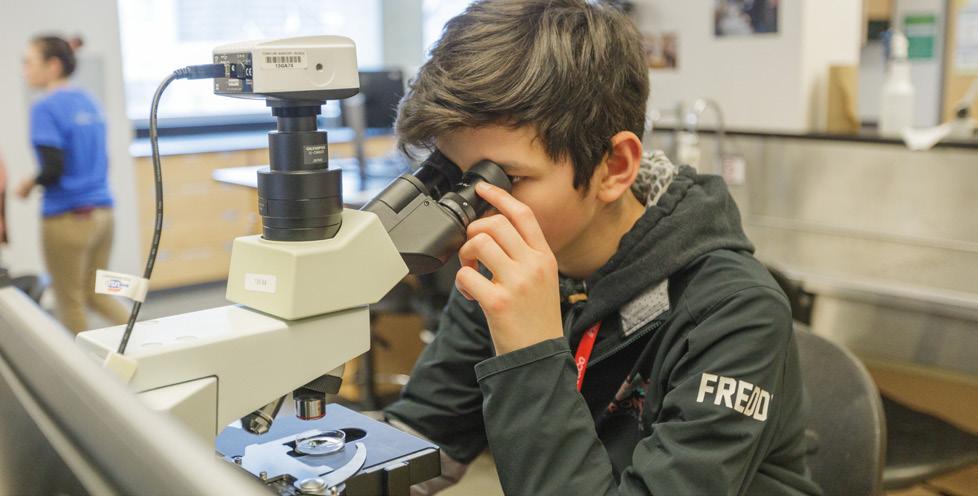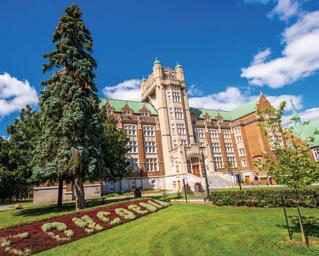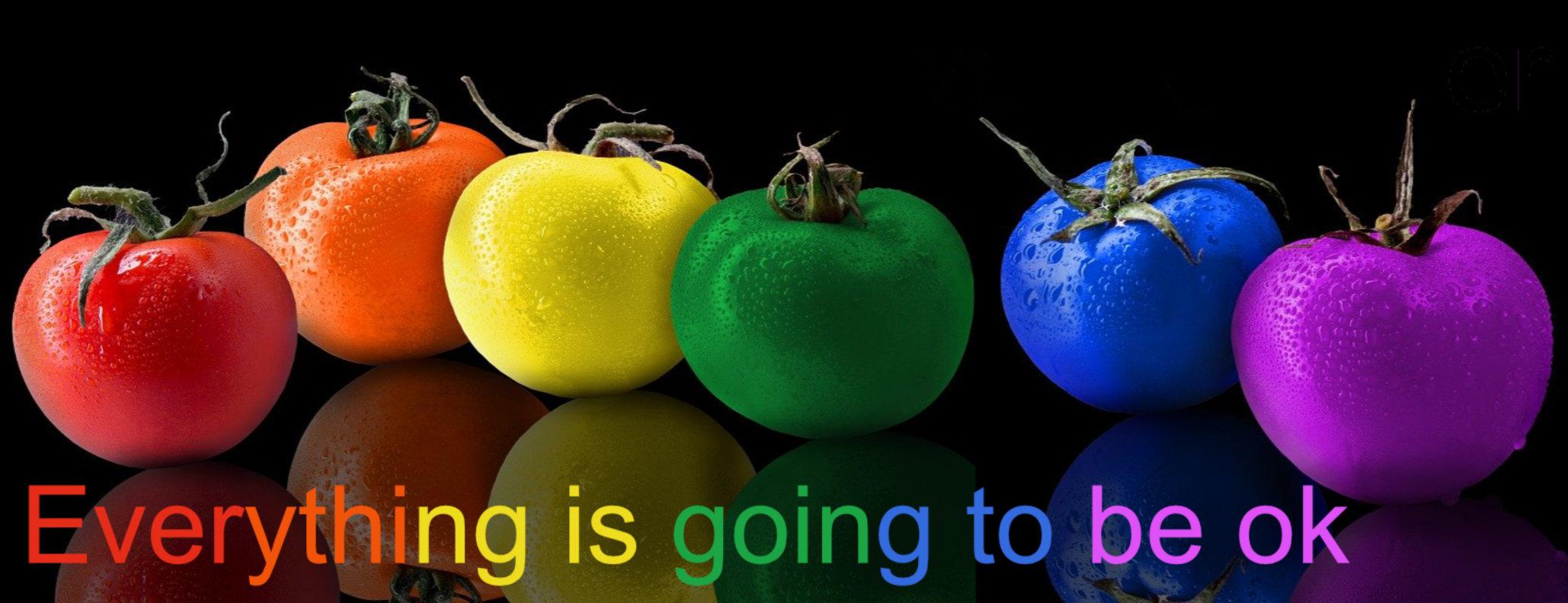


































































































































































































































































































































Over the holidays I went to Ottawa to see my mother and my brother Don. It was a difficult trip, as my father passed away during last year’s holiday. Any time you lose a family member it is difficult, and it lasts for far longer than a single turn around the sun.



Returning to Montreal, I introduced Don to an old friend. He talked about losing his own father in 2018. He shared that his father’s death was even more painful since they had lived together during his last years, and they had become far more than father and son. They were also best friends.
My dad once told me the same thing about his relationship with my brother. Talking with my friend helped me. Many of us don’t work to make a relationship like this happen until time passes us by.
During the visit with my mother a man came to our table. Paul said he had prayed with mom for a miracle. His wife had dementia and would sleep for two or three days straight. But on Christmas morning she woke up, and for the next two days knew who he was and the journey through life that they had shared.
Paul told us that this was a miracle, and that it happened because of the prayers he had shared with my mom. In telling this story, he wasn’t the only one with tears in their eyes.
What was a miracle to him is something many of us take for granted. To be able to talk to family and friends, and they know you, remember what they have done with you – good and bad – memories and love shared through the journey together. Many of us do not realize what a miracle it is to be able to share that love and friendship that we all take for granted.
Think about it. To be able to talk to your mother, father, brother, sister and children and they can respond in a meaningful way doesn’t seem like a difficult interaction, but it could be in a situation where we would pray for a miracle in the way that Paul experienced it.
You may not have the same hopes, prayers or family support that Paul and my mother prayed for to have a real Christmas miracle. It happened regardless of the way one views their relationship with the Creator. Their actions and prayers were an experience that drew people together in many ways.
Things that seem like miracles to others are something the rest of us never really think about when talking to friends or family. Yes, we miss those who have gone before us and that never will stop. But those who are still here but have difficulty remembering us or being the people who we wanted to be with for the rest of our lives still deserve our love.
We want the miracles Paul and my mother prayed for, but we know they are few and far between. Paul misses the partner who he wished would have continue to walk with him along their life path in life. But he had her once again for a couple days and that was a miracle for him.

In this new year, we should try seeing all our relationships with spouses, children, parents, cousins, uncles, aunts, grandparents, friends and others as something extraordinary. Our lives would have little meaning without being able to share them with people we love.
Those things we take for granted are not a guarantee of what will be. Talk to those around you, no matter what age they are. Never let regret be a part of your life because you did not say what you wanted to before it was too late. Being too late to act or speak shouldn’t be a regret we carry until our own last breath.
After a devastating fire destroyed the First Nations Technical Institute’s hangar and fleet of airplanes last year, the FNTI is preparing to welcome a new cohort of students and a rebuilt hangar.
Located in Tyendinaga Mohawk Territory on the Bay of Quinte near Belleville, Ontario, FNTI is an Indigenousowned and -governed institute that has been around for over 35 years. They provide certificate, diploma and degree credentials through partnerships with colleges and universities in Ontario.
FNTI offers an “intensive professional delivery model for students,” VicePresident of Enrolment Management and Student Services Shari Beaver observed. “We were created for those mature learners who have a lot on their plate: mothers, caregivers, people who want to carry on a full-time job but maintain success in a post-secondary environment.”
They can do this by offering credit programs where students can study intensively for one week, then have a three-week break. The school is unique for its “full-campus approach for wraparound supports for Indigenous learners,” Beaver said.

This means that students’ frequent interaction with teachers, cultural advisors and student success facilitators helps ensure that they get through their
classwork – they are “sort of like aunties and uncles,” Beaver joked.
Cultural advisors are important, Beaver explained, since “with our programs, as much as students have regular education outcomes, they’re all tied to Indigenous ways of knowing. They’re tied back to cultural relevancy that they’d be doing in their community.”
Most of the institute’s programs are focused on human services, including Indigenous social work, Indigenous midwifery, mental health and addictions workers, early childhood education, social service workers, social workers, personal support workers, and aviation.
When the Covid pandemic struck, the institute was forced to move entirely online, which allowed them to offer programs to more locations, Beaver noted. Before Covid, FNTI was committed to never going fully virtual, as it didn’t fit with their model of “holding ceremony and coming together,” she explained.
But the pandemic forced the institution to pivot. “We spent the last two years being very intentional, creating Indigenous learning spaces, sitting in virtual circle, knowing it’s sacred when we share and learn together. We’re lucky to have strong faculty, strong cultural advisors, to bridge that space,” s Beaver said.
In 2023 they will move to a hybrid model, in which students can choose
their preferred learning model. The pilot program will remain in-person, just as the personal support worker program continues with in-person labs.
Another specialty of the institute is to deliver a program directly in individual communities. “We might go to Walpole [First Nation, in southwestern Ontario], and bring a cultural advisor and host courses in that community. So, people are learning about education and services where they’re from, but it also removes the barrier,” Beaver said.
“We can offer them these week-long intensive moments without having to worry about stressors like childcare,” she added. “We want to make sure they feel supported, so if things are going on we’re checking in on them to ensure their mental health and wellness.”
FNTI also offers Indigenous health and counselling services, as well as emergency bursaries for online students.
Although the institute lost its hangar and fleet, the program didn’t stop, as FNTI continues to work with private flight schools and lease several planes – keeping students in the air to maintain their hours.
“We’re rebuilding and getting back on our feet,” Beaver said.
Even better, on their wings.
importance of life insurance,


As Nibiischii Corporation celebrates five years of management by the Cree community of Mistissini, it’s been recognized by two major tourism awards in Quebec and Canada.
Nibiischii oversees tourism activities on the AlbanelMistassini-Waconichi Lakes (AMW) Wildlife Reserve. It was a top three finalist for the annual Indigenous Tourism Award given by the Tourism Industry Association of Canada. And in October, it was a top five finalist in the innovation and development category by the Alliance de l’industrie touristique du Québec.
“Being named as a finalist for these awards truly demonstrates the extraordinary tourism potential of our region and the talent and capabilities of the Cree communities,” stated Nibiischii executive director Mireille Gravel. “Local artists, tallymen, knowledge keepers, community leadership, staff members, and our ever-so-supportive partners have all contributed greatly to Nibiischii’s success.”
With biology training, Gravel arrived in Chibougamau in 2007 to work at the environmental/social economy non-profit FaunENord. When management of the wildlife reserve was transferred to Mistissini in 2017 (previously jointly administered with provincial park agency Sépaq), she was recruited to lead its natural environment preservation while gradually opening tourism access.

Nibiischii means “Land of Water, the place where the great natural waters of the North are born.” Its AMW reserve is the largest in Quebec, covering over 15,000 square kilometres. While its spectacular fishing in lakes and rivers attracts up to 7,000 visitors yearly, Nibiischii has evolved its mandate to emphasize eco-tourism amidst Cree culture.
“It’s always been a custom with the Cree to welcome visitors with open arms,” said Mistissini Deputy Chief Gerald Longchap, who had long pushed for Cree control of the reserve. “That was the hunting ground of my great-grandfather. As a child, on this lake, I had the chance to see the canoes made of bark and canvas.”
With the help of several financial and logistical partners, Nibiischii is renovating roads, maintenance buildings, cabins, plumbing and electricity. It’s an opportunity to integrate Cree culture through subtle architectural aspects, information panels and Cree animal names for lodging options.
“We want to make sure that everybody who comes to the wildlife reserve has a taste of the culture, to make sure everybody can feel it’s Cree territory,” Gravel told the Nation. “The infrastructure was quite old so one of the first things we did when we took over was upgrade everything to make sure the quality and security was top-notch.”
Nibiischii is working to expand yearround attractions in harmony with the spectacular natural environment. In addition to 11 log cottages built in the 1950s, two solar powered “Mwakw” floating cabins are now anchored in Cliff Bay, where guests can paddle board, kayak and swim.
“During the summer, we’re already booked a year in advance with fishermen,” Gravel explained. “Starting in 2023, we’ll be fully operational in the fall and winter with a more ecotourism approach. One of our goals is to lessen the pressure on the fish and lakes – I’m convinced that it will be a success.”
This summer, an astronomical observatory and a cinepark on the water will be inaugurated on the reserve. The cinepark is a particularly innovative attraction, enabling visitors to experience the beau-
tiful surroundings while enjoying media presentations that contribute to mutual understanding, cultural awareness and reconciliation.
“One out of three projections will be a documentary, or something linked to Cree culture,” shared Gravel. “Let’s say we’re showing Cree trappers of Mistissini – we’ll have people rowing around in canoes offering bannock or tea so it’s a sight, sound and taste immersive experience.”
A key feature of Nibiischii’s strategy is partnering with Mistissini locals to offer workshops and activities. Nellie Wapachee Gray draws a mix of Crees and non-Natives to popular arts-and-crafts retreats while Willie T. Gunner offers storytelling workshops. Gravel hopes to accompany stargazing at the observatory with Cree storytelling.
As Waconichi is on the Mianscum trapline, family members may stop by to smoke fish, light the teepee fire and introduce themselves as the territory’s hosts. Nibiischii is in discussions with other families about the possibility of hosting more cabins and to offer the cultural expertise of more artists and entrepreneurs.
“Indigenous tourism is seriously popular right now and a lot of people are requesting it,” Gravel asserted. “Ecotourism is low impact, having people live close to the land. People want to learn about the culture when they come here. We want to go slowly so it always
remains authentic and in harmony with the families who occupy the territory.”
From their first interactions through the websites and welcoming office, visitors are given a taste of the Cree language, with a small library of Cree literature available on-site. Although many offerings are still in development, Nibiischii is working with the Cree Outfitting and Tourism Agency to provide virtual workshops, such as an iPad with a small beading kit.
“People are interested in coming but we haven’t done a big push yet,” said COTA executive director Robin McGinley. “It’s more trying to make sure the product on the ground is available and working well. There’s been such a shortage of human resources around the world. We’re exploring interpretive panels that could be self-guided.”
COTA was instrumental in preparing the applications for both of Nibiischii’s awards and continues to streamline online booking for Cree attractions. After a quiet period during the pandemic, anticipation is building for a big tourism summer.
“It’s already very popular for retreats and meetings and it’s not even fully operational yet,” said Gravel. “It’s something that was missing in the region, having gatherings with all the comfort, necessary infrastructure and activities offered. My secret wish is to offer more live cultural workshops – that’s what visitors are looking for when they come here.”









The first National Ribbon Skirt Day was celebrated across Canada January 4. It was inspired by Isabella Kulak, a member of Cote First Nation in Saskatchewan, who was just 10 years old when she was shamed for wearing a ribbon skirt handmade by her auntie to school to a formal dress day in 2020.
Kulak’s family shared her story on social media, receiving support from around the world, and a march was held to walk Isabella back to school after the winter holidays on January 4, 2021. The movement created a ripple effect across the country with many Indigenous women wearing their ribbon skirts in solidarity.
The bill to recognize National Ribbon Skirt Day was passed unanimously by the House of Commons December 15. Prime Minister Justin Trudeau said it was a day for everyone to learn from Indigenous Peoples about their cultures.
Gatherings were held in several communities, and many shared their cultural pride on social media. Women said wearing their skirts helped them honour ancestors and celebrate their resilience. Traditionally worn in ceremonies and special events, ribbon skirts are increasingly worn by Indigenous women to represent their identities.
“I’m just happy that it woke up the world,” said Isabella’s mother Lana Kulak. “It’s like a secret power – makes me stand taller and gives me an extra strength.”
Quebec’s largest education union says Quebec is ignoring the needs of school support staff in Northern Quebec Association of Employees of Northern Quebe-CSQ President Larry Imbeault, president of the .
The labour organization brings together the teaching and school support staff of the Cree and Kativik school boards and the teaching staff of the two Atikamekw schools, along with the workers of two daycares in Eeyou Istchee.
While Northern employer groups say they want to promote the attraction and retention of school support staff,
the AENQ-CSQ believes that several of their demands will have the opposite effect and exacerbate the shortage of personnel in the North.
With school support staff making up 40% of the people working in schools across the province, staff shortage is a major issue. The FPSS-CSQ, the federation exclusively representing school support staff, is calling for quality full-time jobs, the elimination of split shifts, the promotion of all support-stafs and better family-work balance.
“Concrete action was needed from the government to resolve these problems and it completely ignored them instead,” said Imbeault.
Meetings between the negotiating team representing the school boards and those of the CPNCSC and the CPNCSK, the employer negotiating committees of the Cree and Kativik school boards, will begin in January. The exact dates have yet to be determined.
“We will have the opportunity to show them the urgency of improving the working conditions of school support staff,” Imbeault explained. “It will be crucial that the employer party listen.”
The family of Mike Carpenter announced his passing in a statement posted online. Born July 1, 1950, Carpenter had served as the chief of Attawapiskat First Nation in Ontario. He passed away December 20, 2022 and a service was held on December 28.
Grand Chief Alison Linklater stated that Carpenter “steadfastly lead his people with a dedication that is second to none. His unwavering commitment in the advancement of the people he served is felt to this day throughout Omushkegowuk. His accomplishments in life are gifts to us all that we will cherish forever.”
Timmins-James Bay MP Charlie Angus posted condolences, saying, “I had the honour working with him on many files over the years. He is with the angels overlooking the lands he loved so much.
“We will have the opportunity to show them the urgency of improving the working conditions of school support staff”
- Larry Imbeault, President, Association of Employees of Northern Quebe-CSQ

 by Ben Powless Photos provided by the CSB
by Ben Powless Photos provided by the CSB
The Cree Nation Government (CNG) and the Grand Council of the Crees said goodbye to their long-time executive director in December, as Bill Namagoose retired after nearly 35 years in the role. Grand Chief Mandy Gull-Masty announced that Davey Bobbish would step into the position in January.

Namagoose, originally from Waskaganish, first became band manager in 1978 at the age of 21. “Everybody in my generation wanted to help our generation. Our communities were in very dire straits in that time,” he told the Nation

“We’re the generation that saw the initial bulldozer invasion of our communities by Hydro-Québec. There was no recognition we were even there or had any rights,” he said, which inspired him to get involved in public service.
“What [former Grand Chief] Billy Diamond said was we had to get communities out of the rut we were in,” Namagoose explained, saying that communities were impoverished at the time. When he was selected as band manager, he remembers the band office was a “cold, cold building” that didn’t have indoor toilets, just outhouses. The rest of the community was no better, with open sewers but no running water or electricity.
The Grand Council of the Crees was only four years old then, and the school board and the health board had yet to be created. While Namagoose’s job mostly involved basic management, including doing payroll for those working on housing, a large part was pushing for the James Bay and Northern Quebec
Agreement (JBNQA)’s promises to be fulfilled.
“When we signed the agreement in 1975, Canada and Quebec walked away. It took several decades to get them to agree,” he said. Instead, he decided to run for chief, and was elected in 1983 at the age of 26.
When the Crees and Quebec signed the Cree-Naskapi Act (now known as the Naskapi and the Cree-Naskapi Commission Act) in 1984, Namagoose went to bed one night as the last Indian Act chief in Waskaganish and awoke the next morning as the first Cree-Naskapi Act chief.
“But we still didn’t have sewers or water. It costs money,” he lamented. “People thought this would happen overnight.” Namagoose decided to go back to administration in Waskaganish, before
applying for the role of executive director with the Grand Council of the Crees and securing the position in 1988.
He moved to Val-d’Or, where the administrative offices were, until they closed and moved to Nemaska. The Cree Nation, headed at the time by Grand Chief Matthew Coon Come, had just begun a national and international fight against Quebec over the proposed Great Whale River Project hydroelectric development.
If Quebec and Canada weren’t respecting the JBQNA, why should the Cree be obliged to respect Canadian and Québécois sovereignty? “That was Matthew’s point when he ran for Grand Chief,” Namagoose argued. “He said if they won’t respect it, we should stop development.”
Living in Nemaska would have made working on the Great Whale campaign even harder, so Namagoose moved his offices to Ottawa in 1990 to work out of the Cree Nation Embassy. The campaign involved travel to New York on the weekends with the support of environmental groups from the United States.
In 1990, Coon Come organized a canoe trip from Hudson Bay to the Hudson River in New York, to put pressure on the New York state government to abandon planned electricity purchases from the project. Eventually, after massive international pressure, New York withdrew, which led to Quebec and Hydro-Québec dropping the project in 1994.
The Crees would go on to sign several other agreements with Quebec and Canada, starting with the Paix des Braves agreement in 2002 negotiated with the province, the federal New Relationship Agreement in 2008, and the Agreement on Cree Nation Governance signed with Ottawa in 2017, which paved the way for the Cree Constitution the same year.
These agreements and funding commitments allowed the Cree government to focus on social issues and build up their own administration. “The Cree communities transformed from impoverished to modern communities with modern facilities, modern sports arenas, paved streets, and lots of people working. Still, we have many people who need help,” he added.
Now there are over 450 people working for the CNG, and many more employed by the school board and health board. “For me, I’m satisfied, I have no regrets about leaving since the housing program is under way. That was the missing piece, we can resolve that now. Without housing, the communities would not be viable; people would leave,” he said.
He said that Quebec had also come a long way from being “paranoid about the Cree,” saying that they didn’t want to have the words “Cree Nation” recog-
nized in legislation, which led to them using the words “Cree Regional Authority.” “But now they recognized us, and the world didn’t end,” he added with a laugh. However, Namagoose said there’s still more to be done. “We still have to get more autonomy,” from the province and Canada, he said, pointing to the Grande Alliance as a good starting point. He said the Cree Nation could also look to take over more programs from the province and feds, including pensions and old age securities, and doing more economic development.
Speaking to his retirement, Gull-Masty honoured him as the “knowledge-carrier of all the decisions that were made in implementing the JBNQA. He was my go-to person to answer those questions. In addition, I think that Bill has really built the CNG to be a structure that we’ve come to know today, and I’m interested to see how it will evolve after his retirement.”
She said the CNG has benefitted from having a steady administration over decades to implement the decisions set out by the Council Board, as well as being key in federal negotiations. “We’ve been able to really succeed not only in treaties with Quebec but also with Canada,” she added.
Gull-Masty said that Bobbish will have big shoes to fill, but they’ve been working side-by-side since the fall to transfer institutional knowledge. “I want to wish Bill and his family all of the best in the next part of their life and thank [his wife] Jeannie for all her work in supporting him in his role,” she added.
Namagoose was also appointed to the Order of Canada on December 29, in honour of his 45 years in public service. “It’s an honour to be honoured by the people I almost fought against, the government,” he said.
For the Cree, he said he was proud to serve them. “I’m glad they trusted me and the confidence they placed in me was very fulfilling,” he said. “Rights are not something you talk about but breathe life into and become viable. I’m glad to be part of the process.”
As for what’s next, Namagoose said he’s been approached by companies that want to work on reconciliation and want his guidance.
But first, “I’m just going to take a break. I’m going to enjoy my free time,” he shared. “People say when you retire you get busier, but I don’t want to do that. I’ve been busy my whole life; I want to relax and not get bored.”










Priscilla moved from Arviat, Nunavut, to Ottawa in 2016 before deciding she wanted a career change. ree years later, she enrolled in the Early Childhood Education program at Algonquin College as a mature student.
“In 2018, my daughter, who is now ve, was a client in the early years program here in the Indigenous community,” Priscilla said. “I saw the need for Inuktitut/Inuktut-speaking early childhood educators; she was my inspiration to take the program at Algonquin College.”
She said there is high demand for Indigenous early childhood educators, not just in Ottawa but across the country. But another reason is that the college o ers a great support system.
“I decided to take Early Childhood Education through online courses at Algonquin College because my daughter was very young at the time, and I wanted to spend more time with her,” Priscilla explained.
During the Covid pandemic, Priscilla moved over to AC Online (the college’s online campus) to complete her program. ough she could have chosen to remain with her classmates and taken the program over Zoom, she instead chose the exibility AC Online o ered.
“It was a bit of a challenge in the beginning because it was my rst time taking courses online,” she shared. “However, I did get the hang of things quite quickly as I received a lot of support from the faculty. Plus, my classmates were very supportive as well as my family and friends.”
at support was crucial as she found online learning had its unique challenges, but there were unmatched bene ts. “Being a mother to a toddler and a full-time student, I had to manage my time. e facilitators are great, and very helpful. ey’re there for you. Any questions or concerns you may have, you’re able to reach out and they’ll get back to you in a timely manner,” she said.
Now that she’s graduated, Priscilla is humbled that at 47 years old, she is able to inspire other Indigenous people who may want to enrol in online classes. She stated that her nieces and nephews saw her taking courses and said,

She now has a sister in college, as well as a niece taking
Priscilla advises potential Indigenous students to be prepared. While courses may be intense, there is a lot of help available, both from facilitators and classmates. “Algonquin has a great support system such as the Mamidosewin Centre. We had weekly sessions virtually, Algonquin’s Mamidosewin Centre provides academic, career and personal support to all Indigenous students, as well as on-campus amenities and a smudging location that even online students can visit should they wish to.
AC Online o ers more than 80 full-time and part-time program options and more than 800 courses. eir learner-driven focus has led Algonquin College to provide their students with an online learning experience like no other: a complete post-secondary education, in a virtual campus format, with the sta support they would get on a physical campus.









Cree high school graduates have a growing number of options to continue their education journeys. While southern schools continue to expand programs and services for Indigenous students, there are also more post-secondary offerings within Eeyou Istchee.
For instance, the first cohort of the Iyeskuwiiu springboard program graduated last June. A partnership between the Cree School Board and Montreal’s John Abbott College, the one-year program enables Cree students to remain in their home communities through customized online classes and a land-based physical education component.

Those students appreciated deepening their Cree identity in culturally relevant courses while gaining Cegep prerequisites and study skills for their next steps. Applications for the 2023-24 school year will open in the spring.
CSB’s Post-Secondary Student Services department helps students navigate the often-confusing choices of education, career and funding options. They’ll guide you to resources to help transition to student life as an adult. A CSB Post-Secondary Student Conference is scheduled for April 21-23 in Ottawa for students to develop a peer network and meet with potential employers.
Centre d’études
This predominantly French-language Cegep has taken steps in recent years to attract Cree students, including offering three programs in English. Created with funding from the Société du Plan Nord, CECC has a one-year springboard-to-college program and three-year career programs in natural environment technology and accounting and management.
“The greatest thing is they are tailored to Cree students and our trips are to the land,” said administrative officer Émilie Martin. “We create a schedule that allows students to have longer weekends for opportunities to go back to their family. I think our approach is culturally relevant and sensitive to Cree reality and culture.”
Although there are currently few Cree students, CECC has been working to change that through community tours, an Indigenous Student Services office and the new Mîchiwâhp Indigenous student lounge. The Mîchiwâhp features a mural co-created by Waskaganish artist Tim Whiskeychan and a picture photographed by Mistissini artist Brendan Forward.
“We’re enthusiastic to attract more Cree students,” director general Pierre Desjardins told the Nation. “In 2025, we will have an apartment dedicated to First Nations students, couples and families. There will also be rooms for families who want to visit their sons or daughters.”
The largest English-language Cegep in Quebec, Montreal’s Dawson College has vastly expanded its resources for Indigenous students. Its “Journeys” transition program encourages Indigenous students to explore education directions or complete prerequisites for STEM (science,
technology, engineering and mathematics) programs.

“Students come to test the waters, get used to the city life and get a solid family here before they go into their regular program,” explained Journeys co-coordinator Pauline Morel. With an increasing land-based component, it becomes a tight-knit community that offers field trips to Indigenous plays and interactive workshops around the city.
Students Kayla Spencer-Young (from Chisasibi) and Rotshennón:ni Two-Axe have launched an award-winning peer tutoring project to encourage other Indigenous students to pursue STEM fields. The college has a Decolonization Indigenization Studies certificate and is developing credited Cree and Inuktitut classes.
The Indigenous Student Centre is “like going into Auntie’s place for snacks, academic support and other resources,” said Billi-Jo Poirier. “Everyone’s made to feel so welcome, they’re able to grow and lead projects they want to see happening at the college.”
Bordering scenic Gatineau Park, the only English-language Cegep in western Quebec is 10 minutes from downtown Ottawa. Alumnus Caitlin Tolley, an Algonquin legal counsel from Kitigan Zibi, believes Heritage’s small campus is an ideal starting place with kind and patient professors.
Heritage offers an Indigenous Gathering Centre with a dedicated guidance counsellor and an annual Indigenous Culture Awareness Week. Students from Wiininekuu School in Waskaganish visited its campus in December.
This hands-on program teaches future builders how to concrete frame, build and
install furniture, walls, roofs and stairs as well as interior and exterior finishing work. The program will teach students how to plan, calculate and price carpentry projects.
by Amy German
In total, the program is 1,350 hours and is to be completed in a full-time capacity over 54 weeks. It’s currently being offered in Mistissini.
Concordia offers a wide selection of excellent academic programs and a vibrant Indigenous community in the heart of Montreal. Its Otsenhákta Student Centre has expanded this year with new student success and engagement coordinators and they’re working on adding an Elder-inresidence program.
“Many students from Eeyou Istchee come here looking for familiarity and community,” coordinator Katsistohkwí:io Jacco told the Nation. “We host different cultural and community events – we’ve done ribbon skirt and shirt making, also an Inuit mitt making series. Many of our Film and Fine Arts students attended imagineNATIVE in Toronto in the fall.”
As a “next-generation university”, Concordia is renowned for its innovative approaches to experiential learning and cross-functional research, including a recent fish study in Mistissini. Its worldclass facilities are a hub for avant-garde arts, languages, sciences and much more.
Launched in 2021, HEC Montréal, the prestigious business school, offers the First Nations Executive Education program to empower Indigenous leaders with a combination of traditional knowledge and the best of contemporary management practices. It now has four programs, targeted specifically for elected officials and administrators, entrepreneurs, managers and women in leadership.

















Siibii’s growing confidence has allowed them to live a truer life
by Patrick Quinn Local Journalism Initiative Reporterith the new single “YOY” steadily climbing the charts, Cree singer-songwriter Siibii is not only launching the exciting next phase of an already impressive music career but also introducing their first music under their chosen Eenou name.
For the 22-year-old from Mistissini formerly known as Angel Baribeau, the name change a year ago was a decision to live truer to themselves and fully embrace their Eenou Two-Spirit identity. Siibii identifies as trans, queer and non-binary and uses they/them pronouns.

“My growing confidence in my ability as an artist shows in the sound and taking up space as Siibii,” they said. “Feeling more pride having my Eenou name, I think is recognized in the music industry as an act of reclamation, which has influenced my interactions with other Indigenous folks fighting along the same lines within their identities.”
Siibii announced their name change as a way of honouring their gookum (grandmother) Eva, who helped raise them and sparked their love of music. Having been forcefully taken to residential school at age four, Eva hid Siibii’s mother from Indian agents deep in the bush to protect her from the same fate.
Shedding their “biblical” birth name to become Siibii Petawabano, with their

mother’s Cree family name, is a determination to pursue what colonization tried to remove. This courage to honestly express themselves on their own terms is part of what attracts many to Siibii’s music, which often confronts challenging and personal issues in the lyrics.
“It’s definitely lovely to see other folks feeling seen in my lyrics,” Siibii told the Nation. “Isolation is a factor in mental illness so knowing there’s a commonality for a lot of folks is really comforting and it’s lovely to see there are people rooting for me for those very reasons.”


While Siibii has been hailed as a champion of mental health awareness since releasing their debut EP, For Those I Love(d) in 2020, making “YOY” the first song released from their upcoming self-titled album was a deliberate
choice to be even more vulnerable in their art.
Its stirring music video depicts opening line “Getting high instead of getting help” quite literally as Siibii struggles to drag an unidentified burden. With infectious melodies and a soulful groove, the artist interrogates their own coping mechanisms while ultimately seeking self-acceptance through lyrics like “My inner child needs a little help to show some kindness to my future self.”
“I feel a nervousness about being vulnerable around how these topics relate to myself, especially talking about consumption, having not so good days,” Siibii admitted. “I know there’s a relatability to that but it’s scary putting it out there.”
Although Siibii’s lyrics may wrestle with life’s uncertainties, the music sounds more assured than ever, reflect-
ing their remarkable growth as a musician since finding immediate success with their debut, which has already racked up over 300,000 streams. The exciting opportunities that have come with awards recognition haven’t hurt either.
First single “Love is up the River” earned the SOCAN Foundation’s Young Canadian Songwriters Award, while their song “Wish We Were Older” hit #1 on the Indigenous Music Countdown and won the “Best Music Video” award at the Toronto Indie Shorts Film Festival.
As grand prize winner of Canada’s Walk of Fame RBC Emerging Musician Program in 2021, Siibii got a showcase slot at last summer’s Canada Music Week in Toronto along with other prizes and perks like a virtual meeting with singer Sarah McLaughlin. In 2022, they were runner-up in CBC Music’s Searchlight competition.
“Since releasing my music, I’ve been able to survive on just my art, which has allowed me to see how worthy I am of investing in myself,” Siibii shared. “Doing more shows and live sessions forced me to work on my skills as a singer. Pride Winnipeg was one of the highlights of my career – my first ever Pride and I got to sing at it.”
A powerful addition to Siibii’s performance of “Savage” is a sample of former MP Romeo Saganash’s infamous F-bomb when questioning Prime Minister Justin Trudeau in Parliament in 2018. The song has exposed Siibii to a wider audience since it was chosen to open the new Netflix documentary For Love.

“I’m super proud because the documentary is incredibly insightful and important,” said Siibii. “When making that song, my producer had this idea of putting in some relevant news stuff and I immediately thought of [Saganash]. I remember seeing that on TV and thinking that’s incredibly moving.”
Stepping further outside their comfort zone, Siibii recently did some work for Marie Clements’ film Bones of Crows and even voiced a rabbit character in an upcoming children’s project by acclaimed Indigenous author Tomson Highway.
“These experiences allowed me to build my confidence as a vocalist that people want to hire,” Siibii explained. “Using my voice for other projects has added a layer of legitimacy to myself as a professional. That’s really made an impact on how I see myself when it comes to recording and performing.”
With such rapid success, it’s hard to imagine how reluctant Siibii was to join inPath’s initial music workshops in Mistissini, which led to Mikw Chiyâm’s trailblazing arts education program. After Mikw Chiyâm teacher Marcela Henriquez tragically passed away in October, Siibii poignantly reflected on her profound impact through their tumultuous teenage years.
“I was just thinking the other day about who Marcela would have met and how far I’ve come from that person she knew,” Siibii said. “She became my mom – but when I first met her, she was just a teacher coming into the territory. She saw that growth and reminded me often how proud she was.”
As Siibii has become a respected changemaker through arts programming and more recently with a youth fellowship in the international non-profit Darkspark, they hope to eventually develop initiatives for land preservation. While they seem poised for global stardom, they most look forward to touring Eeyou Istchee.
“It would be great to bring the music home, considering this is where I started,” explained Siibii. “I was told successful people create realistic goals, and my first goal is to do Eeyou Istchee because that’s where the centre of my world revolves around.”






First Nations Executive Education (FNEE) offers short leadership programs that have been developed specifically to meet First Nations needs. PROGRAMS DESIGNED



First Nations Executive Education (FNEE) offers short leadership programs that have been developed specifically to meet First Nations needs. PROGRAMS

Elected officials and administrators
Entrepreneurs and business CEOs
Entrepreneurs and business CEOs
Managers, general directors and program directors
Managers, general directors and program directors















On the 2023-2028 Integrated Forest Management Plans – Tactical (PAFIT) for the public forest territory of the Nord-du-Québec region
From January 9 to February 23, the ministère des Ressources naturelles et des Forêts (MRNF) holds a public consultation on the 2023-2028 Integrated Forest Management Plans – Tactical of management units 026-61, 026-62, 026-63, 026-64, 026-65, 026-66, 085-51, 085-62, 086-52, 086-63, 086-64, 086-65, 086-66, 087-51, 087-62, 087-63 and 087-64 located on the public forest territory of the Nord-du-Québec.region.
For the 2023-2028 period, Integrated Forest Management Plans – Tactical (PAFIT) are distributed in the form of four independent modules:
1) Legal and administrative context;
2) Territory and its occupants;
3) Issue analysis;
4)
Integrated Forest Management Plan – Tactical
Although the consultation is limited to module 4, Integrated Forest Management Plan – Tactical, it remains essential that you familiarize yourself with the other modules in order to understand the approach and the various elements supporting the management decisions. For more information, visit the consultation webpage.
During the consultation, the public is invited to comment on the module Integrated Forest Management Plan – Tactical for each of the management units.
Throughout the consultation process, interested parties will be able to consult all of the PAFIT modules and provide their comments on the Integrated Forest Management Plan – Tactical modules using the online form available on the consultation webpage: Québec.ca/consultations-foret-nord-du-quebec.
The PAFITs will also be available on location, by appointment only, by contacting the Department offices listed below.
On Wednesday, January 11, 2023, from 4:30 to 6:30 p.m., the MRNF will hold a virtual information session during which its regional representative will present a summary of the content of these management plans and be available to answer questions.
To attend the session, please register before Wednesday, January 11, 2023, at 12:00 p.m., by email: nord-du-quebec.foret@mffp.gouv. qc.ca. Instructions and an Internet link will be sent by email to the registered people so they can participate in the meeting. Those unable to attend the information session and who would like more information are invited to contact the Department’s offices listed below.
People who do not have access to an Internet service or who want more information are invited to contact the Department by telephone, using the following information:
Unité de gestion de Chibougamau 624, 3e Rue Chibougamau (Québec) G8P 1P1 Telephone: 418-748-2647
Unité de gestion de Mont-Plamondon 645, 1re Rue Est La Sarre (Québec) J9Z 3P3 Telephone: 819-339-7623
Unité de gestion de Quévillon 1121, boulevard Industriel, C. P. 159 Lebel-sur-Quévillon (Québec) J0Y 1X0 Telephone: 819-755-4838
Unité de gestion de l’Harricana-Nord 1122, route 111 Est Amos (Québec) J9T 1N1 Telephone: 819-444-5238
Territory affected by the 2023-2028 Integrated Forest Management Plans – Tactical (PAFIT):

ACROSS
Bottle stopper
Poker token

Like some lingerie
____ the edge
Nitpickers split them
Bounce back
Group of representatives
Wound mark
"Alice Doesn't Live Here ____"
Crack
Fireplace fodder
"See eye to eye", e.g.
Untimely end
Chest protector
Clear of charges
Speck in the sea
Except
Floor it
Brewed drink
Pledge of fidelity 61 Big first for baby 9 Teaching 36 Exhume
Outer border 62 Washstand sessions 39 London cafe
Surfer's ride vessel 10 Stockpile 40 Do damage to
Lustrous fabric 63 Jane's "Grace 11 Burn a bit 42 Animal ailment
Brady mom and Frankie" 12 Days of ___ 43 Without end
Chris whose co-star 15 Like some 45 Bearlike father starred in remarks marsupial "CHiPs" DOWN 18 Gander's mate 48 Tubular pasta
Really bad
Musical finale
iPhone assistant 49 Heidi's home
Personalize, in a 2 Kind of mitt 25 Financial worry 50 Send packing way 3 Depend (on) 26 Affluent outlying 52 Pro's foe
Ness, e.g. 4 Russian citadel area 53 Stringed instru-
Game played on 5 Los Angeles
"Easy Rider" ride ment of old grass team
Animal in a 54 Get a look at
Kind of shirt
Make
Sundial number
Another year is out of the way, with all the holiday games, feasts and activities that filled the week after the big giveaway day. It was a good week, with the community and, lest we forget, those who were not able to be with loved ones around this special time. Yes, life goes on, full swing and roaring to go. And twenty-twenty-three already looks promising.
For many of us, our breaks were stretched a bit due to the holidays falling on weekends. We could welcome the indoor times that are warm and familiar to the heart and soul, simply because it’s darn cold and wintery out there. Best to watch the world go by from the comfort of your living room rather than face the harsh winds of January.
Sometime back in the last century, the practice of community togetherness was a great way to celebrate the mid-winter blahs with feasting and dancing, usually until the wee hours of the morning. Since candy was still considered a delicacy, the famous candy drop from any tall building made the day as all generations scrambled for the treasures that made dentists rich a few months later. The lucky ones got either an apple or orange which was just as revered as the Juju licorice bean. After the mayhem of finding the last of the candy drop, the crowd would move on to the next donors, usually some organization with two-story building.
Later, as Christmas took on the holy viewpoint, it was off to church in your




finest clothes and shiniest slicked-back hair. Yes, the Fonzie look was popular back then and tight-fitting jeans and a black leather jacket elevated you to the pinnacle of coolness.
Of course, everyone smoked tobacco back then. It was considered a sign of maturity and not an addiction, as that word was unknown to us. So, a lot of smoking went on during community events and the lucky ones got to claim a pack of cigarettes left on the hosts’ table for your pleasure.
I didn’t see much in terms of anyone getting drunk or any real rowdiness, except perhaps the local guy who couldn’t build up the courage to dance without a shot of Canadian Club from a discreet mickey.
Family events were simple. Everyone got together and ate a lot of great cooking and smoked a lot of Macdonald tobacco, hand rolled as was the custom. Readymade cigarettes came later, surprising people with a menthol-flavoured option for the ladies.
Alas, as the world grew more knowledgeable, tobacco became the big corporate sin. Today, instead of a manly figure riding a horse while puffing away and ready to rope a helpless heifer, symbols of death and disease now try to deter the addicted and the experimenters.
But those days are past and today we look at the holidays as time for ourselves. Last year, it was about trying to avoid everyone. This year, it’s back to hugging and kissing and laughing and giggling without a worry in the world, apart from the usual holiday shenanigans to spice things up.
Yep, the world is seemingly back to normal. Except for the occasional eruption into war or financial destruction, it’s back to openly bashing everyone and seeding the world with worries and woes and a great gnashing of teeth.
But that’s drama and another story to unfold. Get back to the grind everyone!
Last year, it was about trying to avoid everyone. This year, it’s back to hugging and kissing and laughing and giggling without a worry in the world
In James Bay Cree mythology and legends, one of the recurring characters that comes up is the story of the trickster or wandering spirit. This a mysterious character that wanders around our world and takes on any form it wishes.
It could be a man, a woman, a child, an Elder, or calls itself an older brother or a younger sibling. Sometimes it’s an animal, a bird or a tiny creature. It could just be a spirit that blows in the wind, that speaks from the forest or inhabits the earth or stones or water. Sometimes it’s a monster and sometimes it is a helpful being that saves people. Sometimes it is all intelligent, wise and all-knowing and other times, it is as silly as child or as clumsy as a clown. In many of the stories, it could be a saviour or a bringer of death and destruction.
We call him or her or it many things – as a spirit / god-like being we have stories of Cheekapesh or Nanabush, and as a monster we call it Ochaskeechoo or Windigo.

I like to imagine the dawning of Artificial Intelligence (AI) as this legendary trickster stepping into our world again. Instead of wandering into our world through the water, the trees or as an animal, it is visiting us through the digital medium.
AI software and systems are now actively affecting our everyday lives in many ways whether we would like to admit it or not. Much of the effects of AI can be felt every time we log on to our favourite social media app on our phones, tablets and home computers. All the content we see is fed back to us in
a systematic way to make sure we see only the things we like, agree to or are entertained by.

AI algorithms actively collect as much information about us as possible by recording what we like, what we say, what we post, what we watch, how long we watch it, what time of day, in what location, with which people and a whole bunch more personal information. All that information is fed back to AI systems which then figure out what posts, pictures and ads to send to us automatically.
An example of some current AI technologies that you can interact with are being done by the research laboratory OpenAI through its two projects: DALL-E, which creates new images from your descriptions, and ChatGPT, an automated chat that you can create in with words.

At the workplace, AI is now helping workforces to arrange, collect and process all sorts of data into readable formats to make it easier for people to understand complex and large amounts of information. AI is used in what is known as Natural Language Generation which takes information and automatically turns it into readable formats like charts.

As a writer, I often use a speech-totext recognition software to make my work easier when interviewing. This is automated software which can take a recording of a person’s voice and convert it into text. All of this is done automatically with an app on my phone and the internet. Whenever we go online to deal with a problem with a service by a major company or cooperation, we’ll often be directed to a chat service to talk to some-
one. Often, that chat window will have an automated AI service answering your questions.
AI services to varying degrees are used by companies to manage all sorts of systems and processes in order to help major corporations to make fast decisions. These types of AI services are widely used in the financial sector, healthcare sector and insurance companies.
Another system that has taken hold over the past few years is peer-to-peer networking of systems and computers to share data. This is a system of connected computers that share their abilities to solve complex problems together. This type of system is most famous for making cryptocurrencies possible.
The reason why I like to imagine AI as the trickster is that this legend is there to remind us of a basic lesson in life. This lesson reminds us we are never fully in control of the world, its animals, the environment or even of each other. Any decision we choose to make can either help us or hurt us and we should always be careful.
AI is already affecting the lives of people all over the world and the work that researchers are doing with the support of major governments and corporations is set to make this technology even more powerful and pervasive in our lives. There are benefits to AI, however, I can also see the dangers of what it can do in creating, maintaining and increasing wealth inequality or in deadly advances in automated military software and hardware.
The legend of the trickster is alive and well here today in AI.



